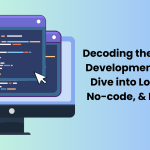The idea of launching an MVP (Minimum Viable Product) lands right after you begin your startup journey. That’s because it has the foresight to validate an entrepreneur’s ideas and explore the right market for the product or service. Understanding the concept of MVP and creating one for your startup allows startups to defer the costs and risks of producing undesired or unneeded products for the audience.

Building an MVP provides a crucial milestone for the growth and success of the business. This article will cover the benefits of MVP development and how it acts as a catalyst for startup success. Before diving into the intricacies, let’s first get to know what an MVP is by definition.
What is an MVP?
An MVP, or Minimum Viable Product, is a minimal version of a new product that includes only the essential features necessary to meet the needs of early adopters. The goal of building an MVP is to gather valuable feedback for future development and minimize risks associated with launching a full-fledged, incompetent product.
The MVP concept is deep rooted in the Lean Startup methodology, which emphasizes a build-measure-experiment-iterate and reiterate approach to product development. Hence, the final product comes out to be high-quality with efficiency in terms of time, cost and resources.
Pros of Building an MVP for Startups
Next, you may think, “Why do entrepreneurs need an MVP for their startups?” Here are a few common benefits of MVP development and its crucial role in the startup’s long-term journey. Let’s begin.
1: Validating Assumptions of Business Model & Market Fit
One of the key advantages of building an MVP is that it helps startups validate business assumptions. Startup owners can test whether their product is ready for the respective market and fulfills the needs of potential customers or requires enhancements based on user feedback.
Moreover, a scaled-down version of the final product helps startups gather feedback from early adopters without spending a dime. This iterative approach allows startup founders to make informed decisions, upgrade pitfalls and ultimately build a feature-rich, market-ready product.
2: Beginning a Cost-Efficient Iterative Development
Embarking on a new product development journey from the outset is not a piece of cake. It requires your dedicated time, resources and blood and sweat. On the flip side, building an MVP allows startups to test the waters and ensures a cost-effective approach to developing fully functional offerings.
Furthermore, an MVP is easy to develop, requires minimum effort from the development team and uses limited resources. As your venture grows and gathers feedback from the audience who used MVP, you are good to go building a full-scale product with prudent investments.
3: Focusing on User-Centric Features
An MVP provides a clear picture of what functionalities users approve of and what needs to be refined. By rejecting unnecessary features, organizations can shift their focus to user-centric elements. This helps them come up with a product that will solve real-life problems.
As a startup owner, if you want to focus on the primary features of a product, creating an MVP will indeed envision this for you.
4: Enabling Customer Engagement
By launching an MVP, a firm tends to connect with its target audience and encourages early customer engagement. As a result of this communication, early adopters feel included in the development of the product and hold a sense of loyalty.
Moreover, companies can get valuable insights and feedback from customers early on through MVPs and make the required changes to produce a product. In this way, they make sure the product meets users’ expectations. Ultimately, this can result in more revenue and sales for the company.
5: Elevating Time-To-Market
In the proliferating world of technology, being first is the essence of everything. Startups also have a tough challenge to combat the speed. With an MVP, businesses may accelerate their time to market, making it possible for them to become visible and start receiving feedback more quickly. This deployment-feedback loop allows entrepreneurs to create a more efficient development process and become agile players.
How to not Misinterpret an MVP?
Many misconceptions are attached to an MVP, making it daunting to build a product around it. It is essential for startup professionals to know the purpose and goal behind launching an MVP. Clearing the air will make it easier to gauge the viability of the product. Let’s discuss some common misconceptions about an MVP here below:
It is not a Prototype
The first and foremost misconception is that an MVP and a prototype are the same. No, it’s not!
An MVP is the initial iteration of your product (limited in functionality), but a prototype is only the first draft of your product that is thrown out after testing. This is the main distinction between an MVP and a prototype. Hence, an MVP and a prototype are two different things.
It is not a Beta Version of Your Product
A Minimum Viable Product and a Beta version of your product are not the same. Although, both intend to gather customer feedback. They are relatively different from one another.
An MVP is targeted to collect responses from random potential customers, whereas a beta version is set out for beta testers and collects feedback from slightly tech-savvy people.
The purpose of an MVP is to check the range of functionalities it must serve to regular customers. On the other hand, the beta version looks for the bugs, performance issues, stability and reliability concerns of the product.
Final Words
Planning an MVP should always be the first step in the product launch journey of a startup. It is impossible to develop a product without hearing from the audience. Also, spending time on a product you won’t even know would be fruitful for users is senseless. So, it should not be taken lightly as it captivates responsiveness with the least effort and resources.



